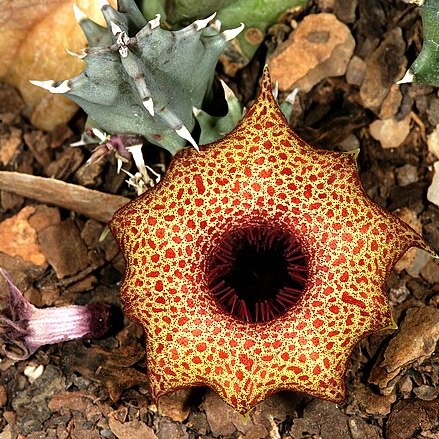Densely clump-forming, glabrous succulent, up to 60 x 300 mm, stems 4-or 5-angled, tuberculate, up to 20 mm diam. Flowers 1-5, in a solitary, sessile cluster near stem base, pedicels 4-12 mm long, spreading. Corolla tubular-campanulate, 14-60 mm diam., inside papillate and glabrous, each papilla tipped with a much longer, clavate bristle, cream with maroon spots and rings, tube 5-20 mm long, lobes deltate, 3-18 x 6-17 mm, without marginal cilia. Corona maroon, outer lobes rectangular and fused to base of tube, inner rising in centre then recurved, tapering to slender tip, with laterally broadened base.
Perennial, dwarf succulent. Stems erect, 20-64 x 10-20 mm, acutely 4-or 5-angled, tuberculate, glabrous, green to reddish. Flowers 1-5; pedicels 6-10 mm long. Sepals ± 8 mm long. Corolla 15-60 mm in diam., tubular-campanulate, yellowish with red spots becoming concentric red lines in tube; papillate from mouth of tube to ± base of lobes, papillae tipped with purple hairs; lobes spreading to ascending, 9-18 x 15-17 mm. Corona 5-8 mm in diam.; outer lobes purple, spreading, notched to bifid; inner lobes purple to cream-coloured, 3-5 mm long, tapering, connivent over column, apex diverging.
Leafless succulent forming dense clumps to 60 cm; sap clear. Flowers tubular-campanulate, tube entirely or irregularly and concentrically marked with maroon, with long, often clavate hairs in mouth of tube and onto petals.

